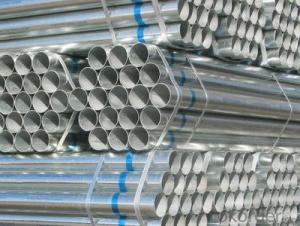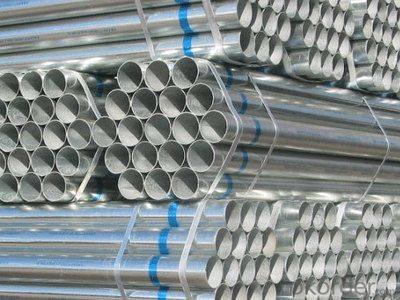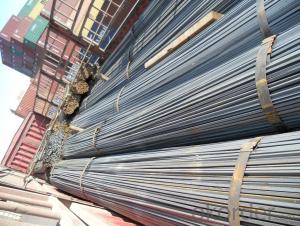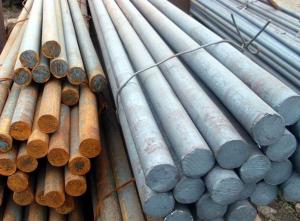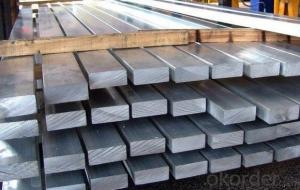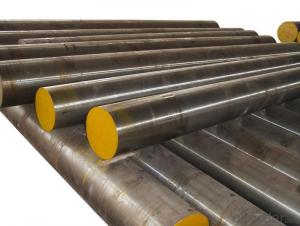Construction Circle Steel Pipe Q235 Grade
- Loading Port:
- Tianjin
- Payment Terms:
- TT or LC
- Min Order Qty:
- 300 m.t.
- Supply Capability:
- 1000 m.t./month
OKorder Service Pledge
OKorder Financial Service
You Might Also Like
Construction Circle Steel Pipe Q235 Grade
Description for Construction Pipe :
Type | Galvanized pipe |
Steel Grade | Q345,Q195,215,Q235, |
Size | DIA 13-25.4mm, 18-25.4mm,25.4-34mm,34-50.8mm,50.8-79.2mm
|
Thickness | 0.5-1.5mm,1.5-2.0mm,0.7-2.0mm,0.8-3.0mm,1.0-3.0mm |
Application | Building/project construction |
Packing | 5.5mm-10mm:packing In coil. 10mm-32mm:in bundle. |
MOQ | 300tons ( trial order 100tons acceptable ). |
Capacity | 15000tons /month. |
Delivery Time | 15days after the order confirmation . |
Payment | T/T , West Union , Cash , L/C. |
Trade Terms | FOB, CFR, CIF ,EXW |
Trans term | FIO , FILO , FLT |
Datas Chart for Galvanized Pipe :
Content | C% | Mn% | Si% | P% | S% | V% | Ceq% |
HRB335 | 0.17-0.25 | 1.00-1.60 | 0.40-0.80 | ≤0.045 | ≤0.045 | ≤0.52 | |
HRB400 | 0.20-0.25 | 1.30-1.60 | 0.40-0.80 | ≤0.035 | ≤0.035 | 0.05-0.08 | ≤0.54 |
HRB500 | 0.25 | 1.6 | 0.80 | ≤0.045 | ≤0.045 | ≤0.55 | |
HRB500E | 0.20-0.24 | 1.20-1.50 | 0.40-0.65 | ≤0.045 | ≤0.045 | 0.050-0.120 | ≤0.55 |
Main Structure of Galvanized Steel Circle Pipe
l Mechanics Performance
Grade | Technical data of the original chemical composition(%) | |||||||
C | Mn | Si | S | P | Ceq | |||
HRB500 | ≤0.25 | ≤1.60 | ≤0.80 | ≤0.045 | ≤0.045 | ≤ 0.55 | ||
Mechanical Characterics | ||||||||
Yield Strength (N/cm2) | Tensile Strength (N/cm2) | Elongation (%)
| ||||||
≥500 | ≥630 | ≥14 | ||||||
FAQ:
Why should you choose us:
Stable quality ----continous casting hot rolled production techenic, strictly quality control system.
Lower price -------Not the cheapest but the lowest price at the same quality .
Good service -----Satisfactory service within 24hours.
Delivery time ------15-25days for the mass production .
Discount---------------discount base on monthly large quantity purchase in long term.
Picture:
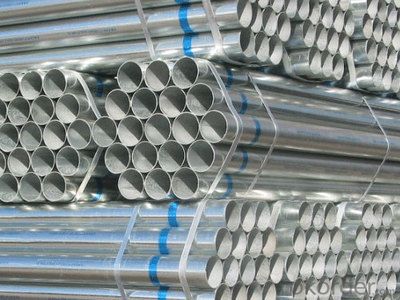
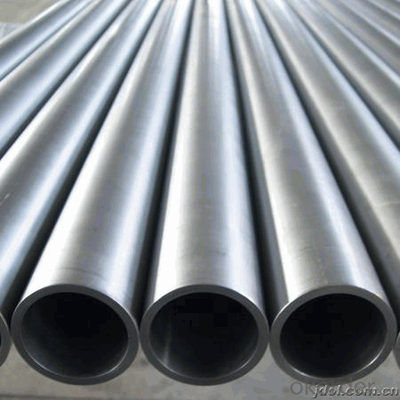
- Q: How are steel pipes threaded for easy installation?
- Steel pipes are threaded for easy installation using a process called threading. Threading involves cutting grooves or ridges into the pipe to create a spiral pattern. This pattern allows the pipe to easily connect with other threaded components, such as fittings or valves. There are two common methods used to thread steel pipes: manual threading and machine threading. In manual threading, a handheld tool called a pipe die is used. The die is equipped with sharp teeth that cut into the pipe as it is rotated. The pipe is secured in a vise or held firmly by hand, and the die is applied to the end of the pipe. The die is then rotated around the pipe, creating the threaded grooves. This process requires skill and precision to ensure accurate and properly aligned threads. Machine threading, on the other hand, is a more automated process. It involves the use of a pipe threading machine, which is equipped with a die head that automatically cuts the threads into the pipe. The machine secures the pipe and rotates it while the die head moves along the length of the pipe, cutting the threads. Machine threading is faster and more efficient than manual threading, making it ideal for large-scale production or projects. Regardless of the method used, it is crucial to ensure that the threads are clean and free from debris or burrs. This is important for easy installation and to prevent leaks or other complications. After threading, the pipes are typically inspected to ensure the threads meet the required specifications. Threading steel pipes allows for easy installation as the threaded ends can be easily screwed into fittings, valves, or other pipes with compatible threads. This threaded connection creates a tight seal, making it suitable for various applications, such as plumbing, gas lines, or industrial piping systems.
- Q: What is the difference between internal and external coating for steel pipes?
- A protective layer is applied to the inner surface of steel pipes, which is known as internal coating. The main purpose of this coating is to prevent corrosion and enhance resistance against chemicals present in the fluid being transported. Techniques like spraying, brushing, or dipping are commonly used to apply the internal coating, and it can be made of materials such as epoxy, polyurethane, or cement mortar. On the contrary, external coating involves the application of a protective layer on the outer surface of steel pipes. The main objective of this coating is to protect against environmental factors like corrosion, abrasion, and impact. External coatings are usually applied through methods like wrapping or coating with materials such as polyethylene, fusion-bonded epoxy, or asphalt enamel. To summarize, the primary difference between internal and external coating for steel pipes lies in their location and purpose. Internal coatings safeguard the inner surface from corrosion and chemical attacks, while external coatings provide protection against environmental damage on the outer surface. Both types of coatings are essential to ensure the durability and reliability of steel pipes in various applications.
- Q: How are steel pipes protected against mechanical damage during transportation?
- Steel pipes are protected against mechanical damage during transportation through various measures. One common method is the use of protective coating or wrapping materials. These coatings are usually made of materials like plastic, rubber, or epoxy, which provide a physical barrier to protect the pipes from scratches, dents, or other forms of mechanical damage. Another method is the use of padding or cushioning materials such as foam inserts or rubber gaskets. These materials are placed inside the pipes or around them to absorb any impact or shock during transportation. This helps prevent any potential damage caused by bumps or vibrations. In addition, steel pipes are often secured and immobilized within transportation containers using straps, braces, or other securing devices. These measures ensure that the pipes remain stable and do not move or collide with each other, reducing the risk of mechanical damage. Furthermore, proper handling and loading techniques are crucial in protecting steel pipes during transportation. This includes using appropriate lifting equipment, such as cranes or forklifts, to avoid dropping or mishandling the pipes. Additionally, pipes are often stored or stacked in a way that minimizes the risk of deformation or bending. Overall, a combination of protective coatings, cushioning materials, securement devices, and proper handling techniques are employed to safeguard steel pipes against mechanical damage during transportation. These measures help ensure that the pipes arrive at their destination in optimal condition, ready for use in various applications.
- Q: Can steel pipes be used for geothermal energy systems?
- Yes, steel pipes can be used for geothermal energy systems. Steel pipes are commonly used for their durability and resistance to high temperatures, making them suitable for transporting hot water or steam in geothermal energy systems. Additionally, steel pipes have excellent corrosion resistance, which is crucial for geothermal environments that often contain corrosive substances.
- Q: Can steel pipes be used for plumbing?
- Yes, steel pipes can be used for plumbing. They are commonly used in commercial and industrial applications due to their durability and strength. However, they are less common in residential plumbing due to their higher cost and the availability of alternative materials such as copper and PVC.
- Q: What does the diameter of a steel pipe project mean?
- Generally, the diameter of steel pipe has three common diameters: outer diameter, inner diameter and nominal diameter.The first two are well understood.Nominal diameter refers to the national standard to specify the general diameter of a certain national standard pipe. It is only a model representation. It is neither outer diameter nor inner diameter.
- Q: How are steel pipes used in the construction of irrigation systems?
- Steel pipes are commonly used in the construction of irrigation systems due to their durability and strength. They are used to transport water from the source to the fields or crops efficiently. Steel pipes can withstand high pressure and are resistant to corrosion, making them ideal for long-term use in irrigation systems. Additionally, their smooth interior surface allows for a smooth flow of water, ensuring efficient water distribution and minimizing the risk of clogs or blockages.
- Q: What are the different methods of joining steel pipes together?
- There are multiple techniques for connecting steel pipes, each with its own pros and cons. 1. Welding, the most commonly used method, involves heating and applying pressure to fuse the pipe ends. This creates a robust joint, but it necessitates skilled labor and specialized equipment. 2. Threaded connections involve threading the ends and using fittings to connect the pipes. This method is relatively simple and quick, but it may not be as strong as welding and can be prone to leakage if not sealed properly. 3. Flanged connections involve using flanges and bolts to connect the pipes. This allows for easy disassembly and reassembly, making it suitable for applications that require frequent maintenance. Flanged connections are also highly resistant to leakage. 4. Compression fittings involve compressing a ring or ferrule onto the pipe to create a tight seal. This method is straightforward and does not require heat or welding, making it ideal for applications where heat or sparks are prohibited. 5. Grooved connections involve cutting grooves into the pipe ends and using mechanical couplings to secure them. This method is fast, reliable, and allows for easy assembly and disassembly. Grooved connections are commonly used in fire protection systems. 6. Brazing, similar to welding, involves heating the pipe ends and adding filler material to join them. This method is often used for smaller diameter pipes and provides a strong joint, but it requires a high-temperature torch and skilled labor. Each method has its own advantages and is suitable for different applications. The choice of joining method depends on factors such as required strength, ease of installation, maintenance requirements, and pipe type.
- Q: 20# seamless steel pipe and seamless steel pipe 20G what is the difference?
- 20#: low carbon steel seamless steel pipe, carbon steel is generally divided into low carbon steel, medium carbon steel and high carbon steel three, 45# steel in carbon steel, low carbon steel is lower than 45#, 45# is higher than that of high carbon steel, seamless steel pipe, such as no special requirements, using 20# seamless steel tube. 20# seamless steel pipe material is 20# steel, the strength is slightly higher than 15#, very little quenching, no temper brittleness. Cold plastic deformation and for bending, rolling, bending and hammer arch processing, arc welding and contact welding welding performance is good, when the thickness is small, prone to strict requirement of shape crack or complex shape parts. The cold or normalizing state of the cutting process is better than that of the annealed one. It is generally used to make workpieces with little stress and high toughness.
- Q: Are steel pipes suitable for underground mining applications?
- Steel pipes are a great choice for underground mining. The mining industry has been using steel pipes for a long time, and they have many different uses, such as supplying water, providing ventilation, and moving materials. Steel pipes are strong and durable, making them perfect for the tough conditions of underground mining. One of the reasons steel pipes are so good for underground mining is their high tensile strength. This means they can handle the pressure and stress from the rock and earth around them. They can also carry heavy loads, which is important for transporting materials and supporting structures in mining tunnels. Another advantage of steel pipes is their resistance to corrosion. This is really important in underground mining, where there's often moisture and chemicals around. With steel pipes, you don't have to worry about them getting damaged and needing to be replaced or repaired all the time. Steel pipes are also easy to weld and join together. This means they can be customized to fit different shapes and sizes to suit the specific needs of each mining operation. To sum up, steel pipes are a fantastic choice for underground mining because they're strong, durable, resistant to corrosion, and versatile. They've been proven to be effective in supporting mining operations and ensuring safety and efficiency.
Send your message to us
Construction Circle Steel Pipe Q235 Grade
- Loading Port:
- Tianjin
- Payment Terms:
- TT or LC
- Min Order Qty:
- 300 m.t.
- Supply Capability:
- 1000 m.t./month
OKorder Service Pledge
OKorder Financial Service
Similar products
Hot products
Hot Searches
Related keywords
